Top surgery (also known as “mastectomy” or “chest surgery”) is a surgical procedure that removes breast tissue, chest muscles and skin, with the goal of creating a masculine-looking chest. In this post we”ll answer question like breast reduction vs top surgery recovery and non binary breast reduction.
Breast Reduction vs Top Surgery

How does FTM Top Surgery Differ from a Breast Reduction?
Thankfully, we now live in a time when people are starting to be accepted for who they are, what they look like, and how they feel inside.
You should be able to look the way you feel, and this is exactly why FTM top surgery was created.
At this time, plastic surgery has developed to the point where we can change anything we don’t like about ourselves. Whether we want our breast bigger, perkier ones, smaller or even none at all, the transformation to a new body is never far away.
As far as the difference between top surgery and breast reduction surgery, here’s how they compare:
FTM (female to male) top surgery was created for people who don’t feel comfortable with the breasts they are naturally endowed with. This mostly appeals to people who are transgender, gender fluid, or identify somewhere else along the spectrum.
FTM top surgery basically removes all of the breasts to give the chest a much more masculine look and feel to it. This is considered cosmetic plastic surgery and won’t be subsidized by the government.
A breast reduction, on the other hand, is surgery to reduce the breasts without completely removing them. Breast reductions are usually sought after to aid with the shoulder and lower back pain that comes along with having naturally large breasts.
Whether they come after having children or simply through the genetic lottery, having large breasts can be a tiring and painful experience. Many times health plans will subsidize the cost of a breast reduction because of the extreme health benefits carrying around less body weight has.
One of the biggest differences between the two surgeries is the amount of scarring; in a breast reduction, the scars are hidden underneath the fold of the breast, whereas in FTM top surgery the scars have nothing to hide behind and are much more visible.
FTM top surgery is generally used as an expression of self from the inside out, whereas breast reduction surgery is to simply decrease the size of the breasts so as to stop them from causing excessive strain on the body.
Either way, the surgeries are intended to make you feel better about your body and positively affect the way you carry yourself. When you look as good on the outside as you feel on the inside, there is very little that can get in your way of being successful.
What Is Female to Male Top Surgery?
Our goal is to help you feel comfortable throughout your transition and listen closely to your aesthetic goals to provide you with the life-changing transformation you desire.
Female to male top surgery, also known as FTM top surgery, is intended to reduce the female breast to create a more masculine chest appearance. Our plastic surgeons, Dr. Neil Zemmel and Dr. Karishma Reddy, are experienced in performing FTM top surgery. Using their extensive training and surgical expertise, our surgeons will work with you to determine the best treatment plan for your unique needs.
At Richmond Aesthetic Surgery, we are proud to help patients as they transition into the gender with which they most identify. Transgender patients can trust that when they seek our surgeons for their sex reassignment, they are receiving the most compassionate, supportive care possible.
What Are the Benefits of FTM Top Surgery?
Undergoing FTM top surgery is a very personal decision, and no one but you can determine whether it is the right choice. If you are considering the procedure and decide to move forward with it, you may experience benefits including:
- A more masculine chest that aligns with your gender identity
- No longer feeling the need to disguise your natural breast tissue
- Boost of self-confidence from your outward appearance
What Does the FTM Top Surgery Procedure Involve?
Our team will educate you on what to expect throughout the process of your female to male (FTM) transgender breast surgery. During your consultation, your surgeon will talk with you in detail about what you hope to achieve through surgery. This along with a review of your medical history and physical needs will allow your surgeon to determine what is necessary to help you obtain your goal results.
FTM top surgery procedures typically entail a breast reduction and often liposuction, as well, for further fat removal. The best technique for each patient – and extent of their procedure – will depend on the amount of breast tissue present. Once the fatty tissue has been removed, excess skin is excised and the area is tightened for a more toned chest appearance. If a large amount of breast tissue is removed, the nipple and areola may need to be relocated to a higher position. More details about your incision options can be found below.
What Are the Different Types of FTM Top Surgery?
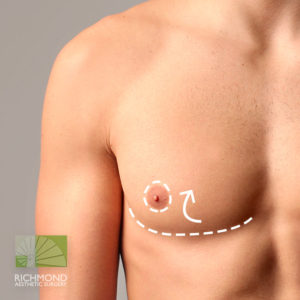
Buttonhole: It involves two incisions made along the inframammary fold (the crease under the breast) and one around the areola. This allows for breast tissue removal, relocation of the areola to a higher position, and excess skin removal. The areola is resized while staying attached by a pedicle, which allows the nerves and blood supply to stay connected and preserve sensation. To reposition the nipple and areola, a circular incision is created at the desired new location. The areola and nipple are then moved underneath the skin and pulled through the new opening where it is sutured into place. Liposuction may also be used to refine the contour of the chest.
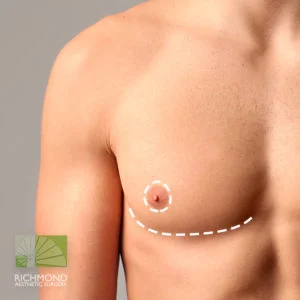
Double Incision: With a double incision technique, a periareolar and inframammary incision is made similar to the buttonhole technique. This again allows breast tissue removal and excess skin removal. With this technique the nipple is completely removed and grafted (free nipple graft) to its new location. Liposuction may be used to contour the chest as well. This technique is typically best for medium to large starting breast sizes.
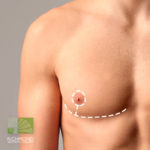
Wise Pattern: The wise pattern technique is similar to a standard breast reduction incision pattern. A periareolar, vertical and inframammary incision are made. This maximizes access to the breast allowing aggressive breast tissue and skin removal. This nipple and areolar may be grafted (free nipple graft) or may be relocated higher on the chest with on a pedicle. Liposuction may be used to contour the chest as well with this technique. This technique may be needed for patients with large breasts.
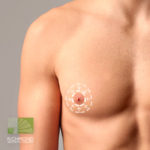
Periareolar: When the periareolar approach is employed, a small incision is made around the border of the areola, and a second, larger circular incision is made, allowing for the skin to be removed. This technique is often best for those with smaller chests and good skin elasticity—it often includes liposuction as well. Once the skin has been removed, a “pursestring” technique is then employed to close the skin and areola. This location typically heals well and is easily concealed since it is on the line between the dark areola skin and the regular skin of the breast.
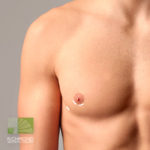
Minimal Scar: Patients with small chests and great skin elasticity are often candidates for the minimal scar technique, which is the least invasive of all techniques. It entails small incisions made on the side of the chest and on a small edge of the areola. Similar to gynecomastia surgery, the minimal scar technique typically uses liposuction to extract fat from the chest for a more masculine appearance with minimal scarring. This technique is used in patients who require minimal breast tissue and skin removal.
What Can I Expect in My Recovery from FTM Top Surgery?
As proud supporters of the LGBTQ community, Dr. Zemmel, Dr. Reddy, and their team are committed to helping transgender patients feel comfortable and confident in their bodies.
Recovery from FTM top surgery will vary based on the individual. A compression garment is often worn to help reduce swelling and improve healing. Drains are removed within the first couple days following your surgery.
Swelling and bruising are normal but should gradually fade as your body heals. Most patients feel comfortable returning to work and their normal routine after about five days. However, strenuous activities should be avoided for several weeks. More specific details of your recovery will be discussed with you during your consultation.
When Will I See My FTM Top Surgery Results?
As your body continues to heal, you can gradually see your new, more masculine breasts taking shape. Due to mild swelling within the weeks following surgery, your breasts may appear fuller than they ultimately will be when fully healed. As a result, it will take some time before you can see what your final outcome will look like. It can take around three months to see your final results.
Like any breast surgery, scarring from FTM top surgery is possible, but our surgeons do their best to minimize scars by placing incisions in easily concealed areas, such as around the areola or in the natural crease underneath the breast. Over time these scars should lighten and fade.
On the 17th I had my chest reconstructed by Dr. Zemmel. I can’t praise him enough! My results are exactly what I was looking for and I couldn’t be happier! I highly recommend Dr. Z to any and all trans men seeking top surgery!
Ryne Musick
How Much Does FTM Top Surgery Cost?
The cost of FTM top surgery is a significant investment for many individuals seeking gender-affirming surgery. Typically ranging from $5,000 to $9,000 for the surgeon’s fee, the total cost will vary depending on several factors.
One key factor that influences the cost of FTM top surgery is the surgeon’s expertise and the geographic location of the practice. Surgeons with more experience and a higher demand for their services may charge more for their fees. Additionally, practices located in urban areas or regions with a higher cost of living may also have higher fees compared to those in rural areas.
Another factor that will affect the total cost of FTM top surgery is the technique employed during the procedure. Different surgical techniques may require different levels of skill and time, which can impact the overall cost. Additionally, anesthesia fees for the surgery will also contribute to the total cost.
Post-surgical garments are another expense that patients should consider when budgeting for FTM top surgery. These garments are designed to provide support and aid in the healing process following surgery. The cost of these garments can vary depending on the type and quantity needed.
During the consultation process, our team will work with you to create a customized surgical plan that meets your specific needs and goals. Based on this plan, we will provide you with a detailed cost estimate for the procedure. If financing is needed to help cover the cost, our staff can assist you in setting up a payment plan to break the total cost into more manageable monthly payments.
In summary, the cost of FTM top surgery can vary depending on several factors, including the surgeon’s expertise, geographical location, surgical technique, anesthesia fees, and post-surgical garments. By working with our team to create a customized surgical plan and exploring financing options, we can help make this important procedure more accessible for those seeking gender-affirming surgery.
| Surgeon’s Fee Range | $5,000 – $9,000 |
|————————–|—————–|
Is FTM Top Surgery Covered by Insurance?
FTM top surgery, also known as female-to-male chest reconstruction surgery, is considered a reconstructive procedure that is often sought out by transgender individuals seeking to align their physical appearance with their gender identity. This surgery involves removing breast tissue and reshaping the chest to create a more masculine contour. For many individuals, FTM top surgery can be a life-changing procedure that helps alleviate feelings of dysphoria and improves overall quality of life.
One important consideration for individuals seeking FTM top surgery is insurance coverage. While gender reassignment surgery is becoming more widely accepted and covered by insurance companies, the level of coverage can vary significantly between providers, states, and specific insurance plans. Some insurance companies may fully cover FTM top surgery, while others may only cover a portion of the costs or have specific requirements that must be met before coverage is provided.
It is crucial for individuals considering FTM top surgery to carefully review their insurance policy and communicate with their provider to understand what is and isn’t covered. Some insurance companies may require preauthorization or documentation from a healthcare provider confirming the medical necessity of the surgery. Additionally, certain insurance plans may have restrictions on which surgeons or facilities are considered in-network for coverage.
It is important to note that FTM top surgery is not considered a cosmetic procedure, but rather a medically necessary treatment for gender dysphoria. As such, it is included in the World Professional Association for Transgender Health (WPATH) Standards of Care as a recommended treatment option for transgender individuals. This recognition of FTM top surgery as a medically necessary procedure has helped pave the way for increased insurance coverage and accessibility for transgender individuals seeking gender-affirming care.
In conclusion, while FTM top surgery is considered a reconstructive procedure and is covered by some insurance companies, it is essential for individuals to carefully review their insurance policy and advocate for coverage when necessary. The landscape of insurance coverage for gender reassignment surgery is evolving, and it is important for individuals to stay informed and proactive in navigating their healthcare options. By working closely with their healthcare providers and insurance companies, individuals can better understand and access the care they need to live authentically and comfortably in their gender identity.
What Risks Are Associated with FTM Top Surgery?
As with any surgical procedure, there comes some degree of risk with FTM top surgery. In addition to milder symptoms, including bruising and swelling, some rare complications are possible. These include bleeding, infection, loss of nipple sensation, and breast asymmetry. Should you have any issues, we will do our best to help correct the issue.

Breast Reduction
Reduction Mammaplasty
A breast reduction, also known as reduction mammoplasty, is a surgical procedure that is performed to remove excess breast tissue and skin in order to achieve a breast size that is more proportionate to the patient’s body. This procedure is commonly sought out by women who have overly large breasts that may cause discomfort, pain, or difficulty with physical activities.
During a breast reduction surgery, the surgeon will make incisions on the breasts to remove the excess tissue and skin. The remaining tissue is then reshaped and the nipples are repositioned to create a more aesthetically pleasing appearance. The goal of the surgery is not only to reduce the size of the breasts, but also to alleviate any physical symptoms that may be associated with large breasts, such as back or neck pain, shoulder grooving from bra straps, and difficulty with exercise or finding clothing that fits properly.
There are a few different techniques that may be used during a breast reduction surgery, depending on the individual patient’s needs and goals. The most common techniques include:
– Anchor incision: This technique involves an incision that goes around the areola, vertically down to the breast crease, and horizontally along the breast crease. This allows for the most amount of tissue removal and reshaping.
– Vertical incision: This technique involves an incision that goes around the areola and vertically down to the breast crease. This technique is often used for moderate breast reductions.
– Liposuction: In some cases, liposuction may be used to remove excess fat from the breasts without the need for extensive incisions. This technique is typically reserved for patients with good skin elasticity and minimal excess skin.
After a breast reduction surgery, patients can expect some swelling, bruising, and discomfort for the first few weeks. It is important for patients to follow their surgeon’s post-operative instructions carefully in order to promote proper healing and minimize the risk of complications. Most patients are able to return to work and light activities within 1-2 weeks, but strenuous exercise and heavy lifting should be avoided for several weeks.
Overall, a breast reduction can have a significant impact on a patient’s quality of life by alleviating physical discomfort and improving self-confidence. It is important for patients to consult with a board-certified plastic surgeon to discuss their goals, expectations, and any concerns they may have before undergoing this procedure.

What is breast reduction surgery?
Breast reduction, also known as reduction mammaplasty, is a procedure to remove excess breast fat, glandular tissue and skin to achieve a breast size more in proportion with your body and to alleviate the discomfort associated with excessively large breasts (macromastia).
Disproportionately large breasts can cause both physical and emotional distress for patients. Patients with macromastia may experience physical discomfort resulting from the weight of their breasts. The resulting pain can make it challenging for some patients to perform common physical activities. Along with the physical ailments of macromastia, some patients may suffer from emotional distress or more significant mental health problems as a result of their large breasts.
Although breast reduction is often performed to address medical issues, patients who do not have the symptoms of macromastia but are unhappy with the size of their breasts can still pursue breast reduction as an aesthetic procedure. Patients choosing to undergo breast reduction surgery for cosmetic reasons may cite any number of factors, including social stigmas and wardrobe concerns.
Breast Reduction Vs Top Surgery Recovery
In order to achieve a breast reduction, breast tissue must be surgically removed. It can reduce the size of your breasts, but it won’t eliminate them completely.
Can You Explain How It Operates?
During a breast reduction, a plastic surgeon will cut away extra skin, fat, and tissue from the breasts. The intention is to achieve a more natural and flattering breast size or to alleviate the discomfort associated with overly large breasts. 1
Reducing the size of one’s breasts through surgery has a very high rate of success and is a permanent procedure. However, alterations to your breasts may occur as a result of pregnancy, weight gain, advancing age, or hormonal changes.
Modifications to the Breasts
Breast reductions are performed in a medical facility. When you’re under the influence of general anesthesia, your plastic surgeon will cut you open and remove any extra skin, fat, or muscle. Their approach will change based on your needs.
To alter the breast shape, the surgeon will reposition the nipple and tighten the skin. Sutures, adhesives, or surgical tape will be used to seal the incision.
To avoid the accumulation of fluid under the skin, you may need to have temporary drains placed. Your doctor will likely remove them for you a week or two after surgery if you do. 2
Effects of Breast Reduction Surgery and How to Manage Them
There is always a chance of something going wrong during surgery, and these include:34
Diarrhea and/or vomiting
Pain
Bleeding
Clots form in the blood
Consequences of, or problems with, anesthesia
Allergies
Infection
Slow wound closure
Necrosis (tissue death) (tissue death)
Scarring
Swelling
Non Binary Breast Reduction
If you identify as non-binary, genderqueer, or gender expansive, you can get top surgery. Top surgery is not contingent on the use of any particular pronouns or the identification of a particular gender by the patient, nor is it contingent on the patient having lived as the desired gender for any specified amount of time prior to the procedure. We also don’t insist that patients take hormones before undergoing breast reduction. Find out more about adipose tissue removal and adipose tissue replacement here.
Please read our introductory page on top surgery for non-binary people first so you can fully appreciate the information provided here.
Anyone having issues with gender identity or with chest pain should seriously consider top surgery. We’ve worked with people who don’t fit neatly into binary categories of either gender to alleviate or completely eradicate their gender-based distress, regardless of the pronouns or hormones they choose to identify with.
Duality in the bust
The aesthetics of binary male and female chests should be discussed at length before moving on to the aesthetics of a non-binary chest. It’s important to remember that many different factors contribute to how people perceive the beauty of breasts. Societal and cultural norms regarding aesthetic preferences also vary greatly across time and space, in addition to body shape and size. Image 1 shows younger-looking breasts on a trimmer frame. Some typical aesthetic features of breasts as they manifest on the body are as follows:
The breasts have a uniform curve, and the nipple is situated in the exact middle of the breast mound to create a teardrop shape.
Breasts are symmetrical in their roundedness.
The fullness of a woman’s breasts can vary significantly between the two breast lobes.
The lower breast has a strong convexity, which means it hangs away from the body. This contributes to the teardrop shape.
Depending on the size of the breasts, the distance between the areolas is anywhere from 30 to 50 millimeters.
Here is a rundown of items typically associated with the aesthetics of the binary male chest. Everyone knows that there is a wide range of body types, even though the individual depicted in Image 2 has a lot of muscle and very little fat. To emphasize the attractiveness of a man’s chest, we use Image 2.
The areolas are more dispersed and smaller (around 22mm, the size of a nickel)
Lesser-positioned areolas can be seen on the chest.
The trunk’s subcutaneous tissue is continuous throughout.
The shape of the lower pec major is like a box or a trapezoid.
There are ways to alter your appearance to make it more masculine or feminine, depending on your preference. Dr. Beck is familiar with the subtleties of the facial musculature and can therefore make the best decisions to achieve the desired results.
Face procedures can help you take the first steps toward a more authentic appearance regardless of your age or your biological gender. Examples of such methods are:
Rhinoplasty
Nose job
Plastic surgery to enhance the appearance of the chin and/or cheeks.
Correction of thin lips
Foreheadplasty
Reduction of the jaw
Shortening the Trachea
Facelift
Eyelid surgery
A TG for fat grafting Fixing Hair Loss
People who do not identify with either the male or female binary exist on a spectrum. Some non-binary people might prefer not to have breasts at all, while others might want to try them out. Dr. Beck is a highly trained and skilled plastic surgeon who specializes in craniofacial surgery, reconstruction, and other forms of advanced plastic surgery, and he is here to help you achieve your aesthetic goals.
